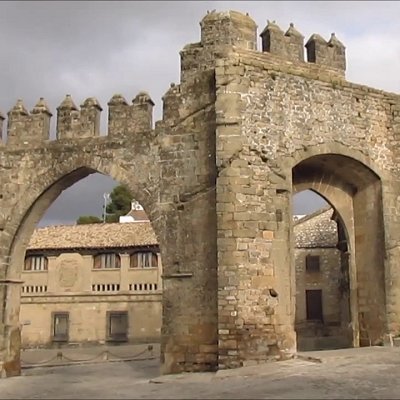
Like us on Facebook
PLACE NAMES




|
|
Baeza
|

|
|
Baeza, formerly also written as Baéza, is an Andalusian town in the province of Jaén in southern Spain. It lies perched on a cliff in the Loma de Úbeda, the range separating the Guadalquivir River to its south from the Guadalimar to its north. It is now principally famed for having some of the best-preserved examples of Italian Renaissance architecture in Spain. Along with Úbeda, it was added to UNESCO's list of World Heritage Sites in 2003. The former Visigothic bishopric of Baeza remains a Latin Catholic titular see.
Landmarks include:
- Natividad de Nuestra Señora Cathedral, presents an early Gothic and Plateresque pilasters and crossed vaults finished in the XVI century in a Renaissance style by renamed architect Andres de Vandelvira, and since 1584 by architect and mathematician Juan Bautista Villalpando. The tower was redone in 1549 and the Chapel of St Michael was added in 1560.
- Town Hall (Ayuntamiento), a Plateresque building originally built as a combined courthouse and prison, leading to two separate main entrances
- Baeza University, established in 1533 or 1538, now a secondary school
- Santa Cruz Church, a Romanesque church with a two-aisle nave and semicircular apse. A side wall incorporates a Visigothic arch.
- St Paul's Church, a Gothic church with a Renaissance portal with a two-aisle nave and Gothic chapels. Includes the tomb of Pablo de Olavide.
- The Chapel of St Francis, in the ruins of a Renaissance building from 1538 formerly used as a monastery
- Jabalquinto Palace (Palacio de Jabalquinto), including an Gothic entrance flanked by two cylindrical pilasters with Plateresque capitals with mocárabes ornamentation, a Renaissance courtyard, and a Baroque staircase
- Spain Plaza (Plaza de España)
- Constitution Plaza (Plaza or Paseo de la Constitucíon), including a marble fountain decorated with Caryatides
- St Mary Fountain (1564)
- The Fountain of the Lions, from the Ibero-Roman ruins of Cástulo and possibly representing Himilce, wife of the Carthaginian general Hannibal
- The Úbeda Gate and Jaén Gate.
- The Villalar Arch (Arco de Villalar), erected for Charles V's 1526 visit to honor his 1521 victory at Villalar.
- Seminary oratorio of St Philip Neri (1660)
 Feel free to Email me any additions or corrections Feel free to Email me any additions or corrections
LINKS AVAILABLE TO YOUR SITE
| | |





